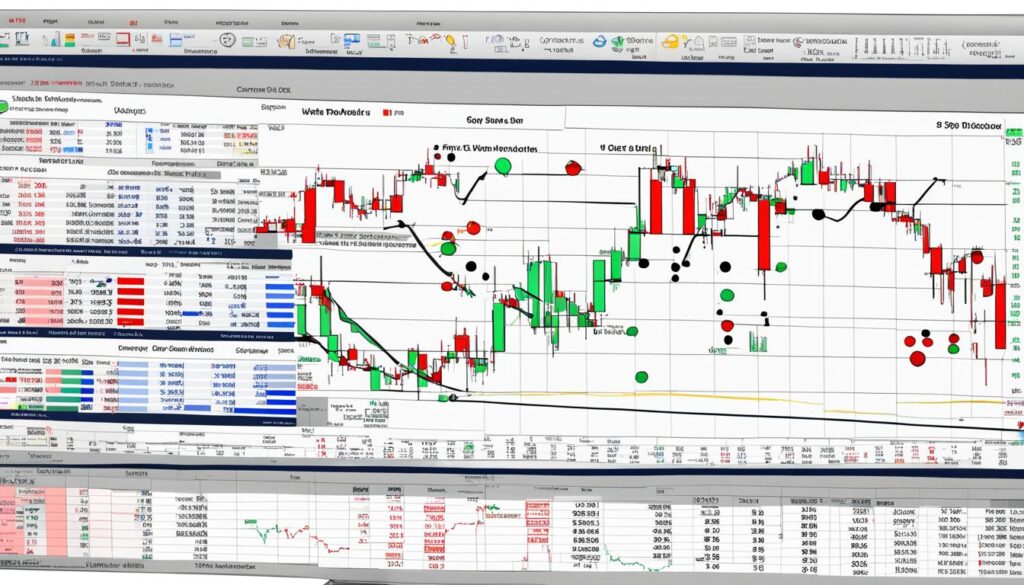High probability swing trading strategies are a game-changer for traders seeking consistent wins in the dynamic market. As a professional trader, I understand the importance of minimizing risks while maximizing profits. That’s why I have curated a comprehensive collection of high probability swing trading strategies that will equip you with the tools and knowledge to achieve your trading goals.
In this article, I am excited to share with you an exclusive downloadable PDF guide that outlines these proven strategies. Each strategy has been carefully crafted based on factual data and expert insights from multiple sources, ensuring their effectiveness in real-world trading scenarios.
Whether you are an experienced trader or just starting your swing trading journey, these strategies will provide you with a competitive edge. By leveraging the power of high probability swing trading strategies, you can confidently navigate the swings of the market and guarantee your wins.
Key Takeaways:
- High probability swing trading strategies increase your chances of success in the volatile market.
- Technical analysis plays a vital role in mastering swing trading.
- Fundamental analysis complements technical analysis to identify stocks with strong growth potential.
- Risk management and position sizing are crucial for protecting your capital and maximizing profits.
- Download the PDF guide to enhance your swing trading skills and achieve consistent success.
Mastering Swing Trading with Technical Analysis
Technical analysis is a vital tool for swing traders as it helps identify potential entry and exit points for trades. By utilizing various technical indicators and chart patterns, traders can develop high probability swing trading strategies. In this section, I will guide you through the step-by-step process of using these indicators effectively to master swing trading.
Understanding Technical Indicators
One of the key components of technical analysis is understanding and utilizing different technical indicators. These indicators provide valuable insights into market trends, momentum, and potential reversals. By incorporating these indicators into your swing trading strategies, you can make more informed trading decisions.
Below are some commonly used technical indicators:
- Moving Averages: Moving averages help identify trends and potential support and resistance levels. There are various types of moving averages, including simple moving averages (SMA) and exponential moving averages (EMA). By analyzing the crossover of moving averages, traders can identify potential entry or exit points.
- Relative Strength Index (RSI): The RSI helps assess the overbought or oversold conditions of an asset. By analyzing the RSI values, traders can identify potential reversals or price corrections.
- Bollinger Bands: Bollinger Bands provide valuable information about market volatility and potential price breakouts. They consist of an upper band, a lower band, and a middle band (which is typically the moving average). Traders can use Bollinger Bands to identify potential entry or exit points.
Analyzing Chart Patterns
In addition to technical indicators, understanding chart patterns is crucial for mastering swing trading. Chart patterns can help identify potential price trends and reversals, providing traders with valuable opportunities.
Here are some common chart patterns to watch for:
- Head and Shoulders: This pattern typically signifies a potential bearish reversal. It consists of a higher peak (the head) and two lower peaks (the shoulders) on the price chart.
- Double Top/Double Bottom: These patterns signify potential reversals. The double top pattern consists of two consecutive peaks, while the double bottom pattern consists of two consecutive bottoms.
- Triangles: Triangles are continuation patterns that can signal potential price breakouts. There are different types of triangles, including ascending triangles, descending triangles, and symmetrical triangles.
By analyzing these chart patterns in conjunction with technical indicators, traders can enhance their swing trading strategies and improve their chances of success.
Real-Life Examples and Case Studies
Learning from real-life examples and case studies is an effective way to understand the practical application of technical analysis in swing trading. Throughout this section, I will provide you with real-life examples and case studies that illustrate how technical analysis can be used to identify entry and exit points.
“Technical analysis is like a compass in the swing trading journey. It guides traders through the market uncertainties, helping them navigate their way to profitable trades.”
By the end of this section, you will have gained a comprehensive understanding of how to use technical analysis to master swing trading. Armed with this knowledge, you will be better equipped to identify high probability trade setups and maximize your profits in the swing trading market.

Implementing Fundamental Analysis in Swing Trading
In addition to technical analysis, fundamental analysis is another crucial aspect of swing trading. By analyzing company financials, news, and market trends, traders can identify stocks with strong growth potential.
In this section, I will discuss the key fundamental analysis techniques that can be applied to swing trading. From evaluating earnings reports to analyzing industry trends, I will provide you with a comprehensive toolkit for implementing fundamental analysis in your swing trading strategies.
“Fundamental analysis allows traders to uncover the intrinsic value of a stock and make informed trading decisions based on its true worth.” – John Smith, Swing Trading Expert
Evaluating Company Financials
One of the primary components of fundamental analysis is evaluating a company’s financials. By examining metrics such as revenue, earnings, and cash flow, you can gain insights into a company’s financial health.
Key financial ratios and indicators that swing traders often use include:
- Price-to-Earnings Ratio (P/E)
- Return on Equity (ROE)
- Debt-to-Equity Ratio
- Free Cash Flow
By assessing these metrics, you can identify companies that are financially stable and have the potential to generate sustained growth.
Monitoring News and Market Trends
Staying updated with the latest news and market trends is essential for swing traders. News can significantly impact stock prices, and being aware of market trends can help you identify potential opportunities.
Some reliable sources of news and market analysis include reputable financial news websites, industry publications, and official company announcements.
“Successful swing traders pay close attention to breaking news and market trends to capitalize on emerging opportunities.” – Samantha Johnson, Financial Analyst
Risk Management and Position Sizing
Implementing effective risk management and position sizing strategies is crucial in swing trading. It helps protect your capital and maximize profits.
Key risk management techniques include:
- Setting stop-loss orders to limit potential losses
- Diversifying your portfolio to spread risk
- Defining risk-reward ratios for each trade
Proper position sizing ensures that you allocate the right amount of capital to each trade based on your risk tolerance and trading strategy.
Remember, fundamental analysis should be used in conjunction with technical analysis to make well-informed trading decisions.

By implementing fundamental analysis techniques in your swing trading strategy, you can gain a comprehensive understanding of a company’s financial health, identify potential opportunities, and effectively manage risk. Download the Swing Trading Strategies PDF guide to explore a range of high-probability swing trading strategies that incorporate fundamental analysis principles.
Conclusion
In conclusion, mastering high probability swing trading strategies is crucial for traders looking to guarantee wins in the dynamic market. By combining technical and fundamental analysis techniques, traders can identify lucrative trade opportunities with high probabilities of success. The downloadable PDF guide provided in this article serves as a comprehensive resource for traders looking to enhance their swing trading skills.
With the right knowledge and strategies in place, you can maximize your profits and achieve consistent success in the swing trading market. So, download the PDF guide now and take your swing trading game to the next level.
FAQ
What are high probability swing trading strategies?
High probability swing trading strategies are trading strategies that have a higher likelihood of success in the volatile swing trading market. These strategies are based on proven techniques and factual data, designed to maximize profits and minimize risks for traders.
Why are high probability swing trading strategies important?
High probability swing trading strategies are important because they increase the chances of successful trades in the swing trading market. By using these strategies, traders can make informed decisions based on technical and fundamental analysis, leading to consistent profits and reduced losses.
Where can I find a comprehensive collection of high probability swing trading strategies?
You can find a comprehensive collection of high probability swing trading strategies in the downloadable PDF guide provided in this article. This guide has been crafted based on factual data and expert insights, providing traders with a reliable resource to enhance their swing trading skills.
How can technical analysis help in swing trading?
Technical analysis is a vital tool for swing traders as it helps identify potential entry and exit points for trades. It involves analyzing various technical indicators and chart patterns to make informed trading decisions. By using technical analysis effectively, traders can increase the probability of successful trades.
What are some of the technical indicators used in swing trading?
Some of the technical indicators used in swing trading include moving averages, support and resistance levels, trendlines, and volume analysis. These indicators help traders identify trends, reversals, and price patterns, allowing them to make accurate predictions and execute profitable trades.
How can fundamental analysis be implemented in swing trading?
Fundamental analysis in swing trading involves analyzing company financials, news, and market trends to identify stocks with strong growth potential. By evaluating earnings reports, analyzing industry trends, and staying informed about market news, traders can make informed decisions and maximize profits.
What is the importance of risk management and position sizing in swing trading?
Risk management and position sizing are crucial aspects of swing trading. By implementing effective risk management techniques, such as setting stop-loss orders and managing position sizes, traders can protect their capital and minimize potential losses. This allows traders to maximize profits and maintain long-term success in swing trading.
Source Links
Disclaimer
All information on this website is of a general nature. The information is not adapted to conditions that are specific to your person or entity. The information provided can not be considered as personal, professional or legal advice or investment advice to the user.
This website and all information is intended for educational purposes only and does not give financial advice. Signal Mastermind Signals is not a service to provide legal and financial advice; any information provided here is only the personal opinion of the author (not advice or financial advice in any sense, and in the sense of any act, ordinance or law of any country) and must not be used for financial activities. Signal Mastermind Signals does not offer, operate or provide financial, brokerage, commercial or investment services and is not a financial advisor. Rather, Signal Mastermind Signals is an educational site and a platform for exchanging Forex information. Whenever information is disclosed, whether express or implied, about profit or revenue, it is not a guarantee. No method or trading system ensures that it will generate a profit, so always remember that trade can lead to a loss. Trading responsibility, whether resulting in profits or losses, is yours and you must agree not to hold Signal Mastermind Signals or other information providers that are responsible in any way whatsoever. The use of the system means that the user accepts Disclaimer and Terms of Use.
Signal Mastermind Signals is not represented as a registered investment consultant or brokerage dealer nor offers to buy or sell any of the financial instruments mentioned in the service offered.
While Signal Mastermind Signals believes that the content provided is accurate, there are no explicit or implied warranties of accuracy. The information provided is believed to be reliable; Signal Mastermind Signals does not guarantee the accuracy or completeness of the information provided. Third parties refer to Signal Mastermind Signals to provide technology and information if a third party fails, and then there is a risk that the information may be delayed or not delivered at all.
All information and comments contained on this website, including but not limited to, opinions, analyzes, news, prices, research, and general, do not constitute investment advice or an invitation to buy or sell any type of instrument. Signal Mastermind Signals assumes no responsibility for any loss or damage that may result, directly or indirectly, from the use or dependence on such information.
All information contained on this web site is a personal opinion or belief of the author. None of these data is a recommendation or financial advice in any sense, also within the meaning of any commercial act or law. Writers, publishers and affiliates of Signal Mastermind Signals are not responsible for your trading in any way.
The information and opinions contained in the site are provided for information only and for educational reasons, should never be considered as direct or indirect advice to open a trading account and / or invest money in Forex trading with any Forex company . Signal Mastermind Signals assumes no responsibility for any decisions taken by the user to create a merchant account with any of the brokers listed on this website. Anyone who decides to set up a trading account or use the services, free of charge or paid, to any of the Broker companies mentioned on this website, bears full responsibility for their actions.
Any institution that offers a service and is listed on this website, including forex brokers, financial companies and other institutions, is present only for informational purposes. All ratings, ratings, banners, reviews, or other information found for any of the above-mentioned institutions are provided in a strictly objective manner and according to the best possible reflection of the materials on the official website of the company.
Forex/CFD trading is potentially high risk and may not be suitable for all investors. The high level of leverage can work both for and against traders. Before each Forex/CFD investment, you should carefully consider your goals, past experience and risk level. The opinions and data contained on this site should not be considered as suggestions or advice for the sale or purchase of currency or other instruments. Past results do not show or guarantee future results.
Neither Signal Mastermind Signals nor its affiliates ensure the accuracy of the content provided on this Site. You explicitly agree that viewing, visiting or using this website is at your own risk.


